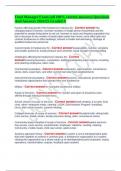Food Manager Exam (all 100% correct answers) Questions
And Answers 2024/25 Graded A
Factors affecting growth if the foodservice industry (6) - Correct answerThe
changing status of women, increase numbers of single person households and the
potential for people living alone to eat out, increase in asian and hispanic population has
led to decrease in the number of meals eaten awau from home, more office jobs and
contract foodservice in office buildings, interest in health and well-being, shortage of
qualified foodservice personnel
Current trends in foodservice (5) - Correct answerSustainability, nutrition, simplicity
and smaller portions $, locally produce wine and beer, liquid nitrogen freezing/chilling
Challenges affecting the foodservice industry (5) - Correct
answerEconomy/recession, competition, building/maintaining sales volume, recruiting
and retaining employees, labor costs
Commercial (examples) - Correct answerrestaurants, supermarkets, convenience
stores, delis, snack bars, and other commercial retail food establishments
Noncommercial (examples) - Correct answerbusiness, educational, governmental or
institutional organizations that operate their own foodservice
Military - Correct answerno examples foodservice military
Scope of Services - Correct answerThe number and types of bussiness units
offered through indivdual foodservices
School version of scope of services - Correct answerretail-vending, a la carte, food
court. other- employee meals, catering. USDA Child Nutrition Program- breakfast,
lunch, after school snacks, summer feeding.
College/University of scope of services - Correct answerResident halls- dining halls,
room service. Retail- kiosks, faculty executive dining, delis, convenience stores.
Community-based Hospital of scope of services - Correct answerpatient services-
tray service, room service, nourishments. Employee- cafeteria, vending, catering.
Community- mobile meals, child care center, adult center.
Systems approach theory - Correct answerA system is set of interdependent parts
that work together to achieve a common goal. A foodservice organization is a system.
viewing the organization as a whole made up of interdependent parts (subsytem, inputs,
operations, transformation, outputs, feedback open system)
, subsystem - Correct answerthe interdependent parts of a system the parts of a
system.
inputs - Correct answerresources such as money. material, time, information
required by a system.
operations - Correct answerthe work performed to transform inputs into outputs
transformation - Correct answerthe process required to change inputs into outputs
outputs - Correct answerfinished products and services of an organization
feedback - Correct answerinformation on how operations worked or failed or how
they should be changed to restore equilibrium
Conventional foodservice (advantages and disadvantages) - Correct answerRaw
foods are purchased, prepared on site and served soon after preparation (advantages-
quality control, menu flexibility, less freezer storage required. Disadvantages- stressful
workday, difficulty in scheduling)
Ready- Preapred (cook/chill or cook/freeze. advantages and disadvantages) - Correct
answerFoods ar eprepared on site then chilled or frozen and stored for reheating at a
later time. (Advantages- reduction of peaks and valleys of workloads, reduction in labor
cost, improved quality and quantity control. Disadvantage- need for large cold storage
and freezer units, need for costlky rethermalization equipment in some cases)
Commissary (advantages and disadvantages) - Correct answerA central production
kitchen or food factory with centralized food purchasing and delivery to off-site facilities
for final preparations (Advantages- large volume food purchasing reduce costs, effective
and consisten quality control. Disadvantages- many critical points where contamination
of food can occur, specialized equipment and trucks are needed for food safety, high
cost of equipment and equipment maintenance)
Assembly/serve (advantages and disadvantages) - Correct answerAlso known as
the kitchenless kitchen, fully prepared foods are purchased, stored, assembled, heated
and served (Advantages- labor savings, lower procurement costs, minimal equipment
and space requirements. Disadvantages- limited availability of desired menu items, high
cost of prepared foods, additional freezer space, concern over recycling or disposing of
packaging materials.)
Centralized delivery - Correct answerPrepared foods are portioned and assembled
at a central area and then the completed orders and transported and delivered to the
consumer




